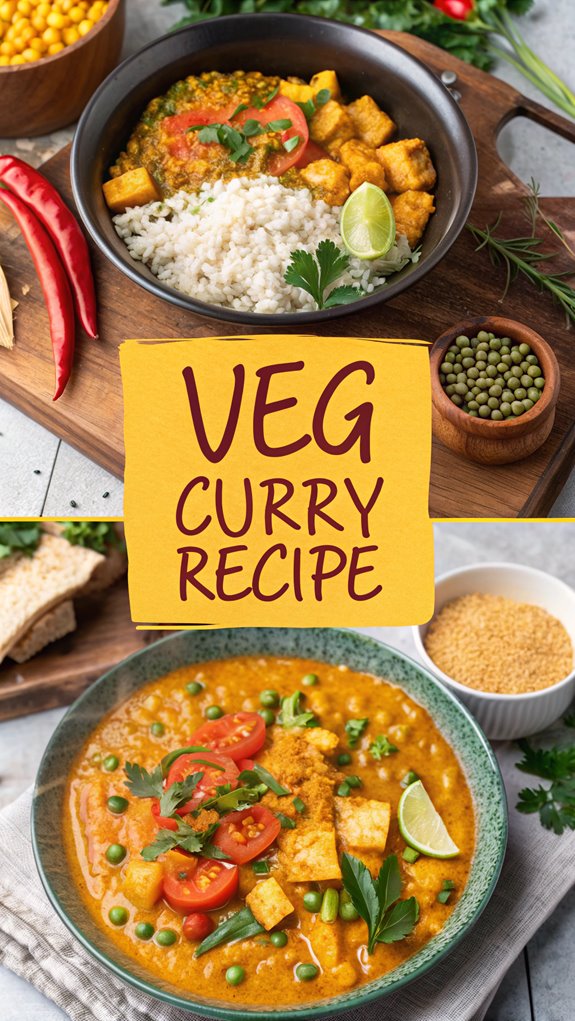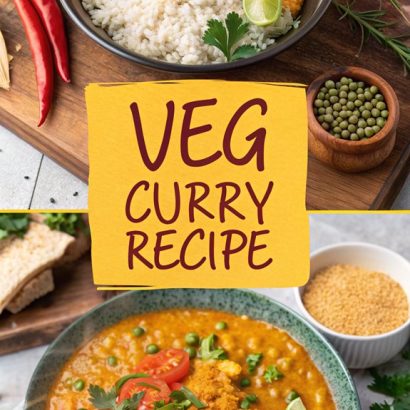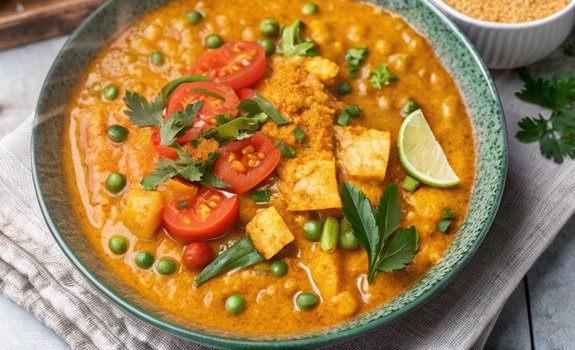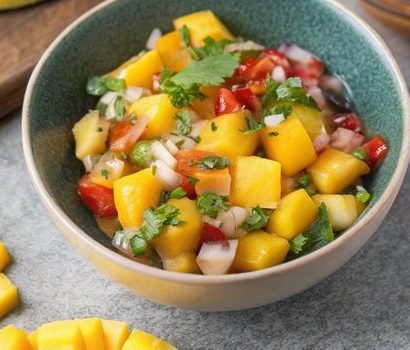Veg Curry Recipes Indian Foods
Like a vibrant tapestry woven with spices and vegetables, Indian veg curry recipes bring a rich culinary tradition to your kitchen. You might be surprised to discover how simple ingredients can transform into a hearty meal that’s both satisfying and nutritious. With the right techniques, you can create a dish that caters to various dietary preferences while tantalizing your taste buds. But what makes these curries truly special isn’t just the flavors; it’s the stories behind them that enrich your cooking experience. Curious about how to make your own?
Why You’ll Love This Recipe
When you plunge into making veg curry, you’ll quickly discover its incredible versatility—whether you want to use seasonal vegetables or experiment with different spices, there’s something for everyone.
You can choose from a variety of vegetables like potatoes, cauliflower, and bell peppers, tailoring the dish to your taste. Spice blends like pav bhaji masala or kitchen king masala can completely change the flavor.
If you’re vegan, just swap yogurt for coconut milk. Plus, this dish is nutritious, providing essential vitamins and minerals while being low in calories, making it a great source of high dietary fiber.
Cooking is easy, too; you only need common ingredients and one pan. You can even batch cook for quick meals throughout the week.
Veg curry truly adapts to your needs!
History
Veg curry’s rich history adds depth to its appeal, showcasing centuries of culinary evolution. Its origins trace back to the Indus Valley Civilization around 2600 BCE, where cooking methods began to develop.
The Vedas highlight spices like ginger and garlic, indicating early flavor experimentation. Archaeological findings in Farmana confirm the use of turmeric and garlic between 2500-2000 BCE.
With the arrival of the Portuguese and British, new ingredients like chilies and tomatoes transformed curry into a global dish. During the Mughal Empire, nuts and saffron enriched recipes, creating regional variations. Curry’s historical significance is evident as it reflects the fusion of various culinary traditions over time.
Today, veg curry reflects a blend of cultural influences, from Indian to Caribbean, making it a versatile favorite worldwide, celebrated for its rich flavors and adaptability.
Recipe

Veg Curry Recipe
Veg curry is a delightful and versatile dish that brings together a medley of vegetables in a rich, aromatic sauce. With its roots in Indian cuisine, this dish can be tailored to suit your taste preferences, making it a perfect choice for both novice cooks and seasoned chefs. The combination of spices and creamy elements creates a comforting meal that can be enjoyed with rice, roti, or naan. This recipe is highly rated, with a score of 4.97 from 222 votes, showcasing its popularity among those who have tried it.
To create a satisfying veg curry, you’ll need a variety of fresh vegetables and some essential pantry staples. The base of the curry is built with sautéed onions, garlic, and ginger, enhanced by a blend of whole and ground spices. Adding a creamy element like coconut milk or cashews will elevate the dish, providing a luscious texture and depth of flavor. Let’s plunge into the recipe!
Ingredients:
- 2 cups mixed vegetables (potatoes, carrots, green beans, peas)
- 1 large onion, finely chopped
- 1 tablespoon ginger, minced
- 1 tablespoon garlic, minced
- 2 medium tomatoes, pureed or chopped
- 1 teaspoon cumin seeds (optional)
- 1 bay leaf (optional)
- 2 green cardamoms (optional)
- 1 teaspoon turmeric powder
- 1 teaspoon coriander powder
- 1 teaspoon cumin powder
- 1 teaspoon garam masala
- 1 cup coconut milk or heavy cream
- Salt to taste
- Fresh cilantro for garnish
- Water or vegetable stock as needed
- Oil for cooking
Cooking Instructions:
- Heat oil in a large pan over medium-high heat. Add the chopped onions, ginger, and garlic. Sauté until the onions turn golden brown and aromatic.
- If using, add the cumin seeds, bay leaf, and green cardamoms. Sauté for an additional minute until the spices release their fragrance.
- Stir in the turmeric, coriander, and cumin powders. Cook for about 30 seconds until the spices are well combined and aromatic.
- Add the pureed or chopped tomatoes and cook until the mixture thickens and the oil starts to separate from the base, about 5-7 minutes.
- Introduce the mixed vegetables and stir to coat them in the spice mixture. Add water or vegetable stock to cover the vegetables. Bring the mixture to a boil, then reduce the heat and let it simmer for 15-20 minutes or until the vegetables are tender.
- Once the vegetables are cooked, stir in the garam masala and coconut milk/heavy cream. Adjust the seasoning with salt and simmer for an additional 5 minutes.
- Garnish with fresh cilantro and serve hot with rice, roti, or naan.
For those looking to enhance their veg curry experience, consider these extra tips: Adjust the spice levels to your liking by adding more or less chili powder, or experimenting with different spice blends for a unique flavor profile.
Blanching your vegetables before adding them to the curry can help speed up the cooking process and retain their vibrant colors. Ultimately, if you prefer a thicker curry, simply simmer it longer to achieve your desired consistency. Enjoy your cooking!
Final Thoughts
Cooking a delicious vegetable curry isn’t just about following a recipe; it’s an opportunity to explore flavors and create a nourishing meal. With options like mixed vegetables, spices, and cooking methods, you can customize your dish to fit your taste. Remember to balance the spice levels to guarantee it suits your palate. Nutritionally, vegetable curries are low in fat, high in fiber, and packed with essential vitamins and minerals, making them a healthy choice. Additionally, they are typically high in dietary fiber, which supports digestive health. Experiment with different ingredients and regional styles to make each meal unique. Serve your curry with rice, naan, or other flatbreads for a complete experience. Embrace the versatility of vegetable curries, and enjoy the rewarding process of cooking!
FAQ
Have questions about making vegetable curry? First, always use authentic spices like cumin, coriander, and garam masala for true flavor. Don’t just stick to curry powder; experiment with different spice combinations.
Remember to chop your vegetables into similar sizes for even cooking. Cook harder veggies like carrots first, then add softer ones later. You can use a variety of mixed vegetables like potatoes, carrots, and green peas to create a colorful and nutritious dish.
When making the curry base, sauté onions until they’re golden, and include ginger and garlic for depth. Use fresh tomatoes, cooking them until they’re pulpy.
For a creamy texture, consider adding yogurt or cream. Serve your curry with naan or roti, and don’t forget to garnish with fresh coriander.
If you have leftovers, refrigerate them for up to two days. Enjoy your cooking!

VEG CURRY RECIPES INDIAN FOODS
Ingredients
- INGREDIENTS:
- 2 cups mixed vegetables potatoes, carrots, green beans, peas
- 1 large onion finely chopped
- 1 tablespoon ginger minced
- 1 tablespoon garlic minced
- 2 medium tomatoes pureed or chopped
- 1 teaspoon cumin seeds optional
- 1 bay leaf optional
- 2 green cardamoms optional
- 1 teaspoon turmeric powder
- 1 teaspoon coriander powder
- 1 teaspoon cumin powder
- 1 teaspoon garam masala
- 1 cup coconut milk or heavy cream
- Salt to taste
- Fresh cilantro for garnish
- Water or vegetable stock as needed
- Oil for cooking
Instructions
- COOKING INSTRUCTIONS:
- Heat oil in a large pan over medium-high heat. Add the chopped onions, ginger, and garlic. Sauté until the onions turn golden brown and aromatic.
- If using, add the cumin seeds, bay leaf, and green cardamoms. Sauté for an additional minute until the spices release their fragrance.
- Stir in the turmeric, coriander, and cumin powders. Cook for about 30 seconds until the spices are well combined and aromatic.
- Add the pureed or chopped tomatoes and cook until the mixture thickens and the oil starts to separate from the base, about 5-7 minutes.
- Introduce the mixed vegetables and stir to coat them in the spice mixture. Add water or vegetable stock to cover the vegetables. Bring the mixture to a boil, then reduce the heat and let it simmer for 15-20 minutes or until the vegetables are tender.
- Once the vegetables are cooked, stir in the garam masala and coconut milk/heavy cream. Adjust the seasoning with salt and simmer for an additional 5 minutes.
- Garnish with fresh cilantro and serve hot with rice, roti, or naan.
- For those looking to enhance their veg curry experience, consider these extra tips: Adjust the spice levels to your liking by adding more or less chili powder, or experimenting with different spice blends for a unique flavor profile.
- Blanching your vegetables before adding them to the curry can help speed up the cooking process and retain their vibrant colors. Ultimately, if you prefer a thicker curry, simply simmer it longer to achieve your desired consistency. Enjoy your cooking!



